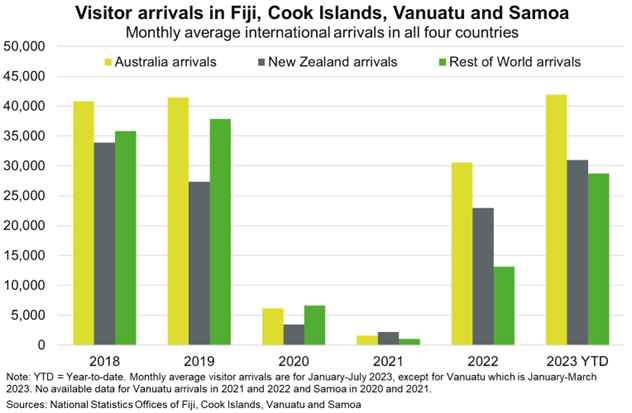Pacific Islands—Australian visitors lift tourism as rest of the world lags
Strong travel demand from Australia and New Zealand continues to buoy the recovery in South Pacific Islands tourism. On average, more than 40,000 Australians and 30,000 New Zealanders travelled to Fiji, Cook Islands, Vanuatu and Samoa each month in the first seven months of 2023, surpassing pre-pandemic levels (Chart). But travellers from key Asian markets and the US and Europe have been slower to return, meaning the South Pacific is yet to reach pre-pandemic levels of international arrivals overall. An outsized reliance on tourists from East Asia is weighing particularly hard on countries in the North Pacific. The North Pacific is also more vulnerable to competition from growing tourism markets in Southeast Asia.
Forward bookings for airlines and hotels suggest recovery in Pacific Islands tourism will be sustained in 2024. Fiji Airlines indicate bookings from August 2023 to July 2024 are 35% ahead of 2019 levels. The robust jobs market supports continued Australian and New Zealand demand. The Pacific will remain a popular travel destination for Australians and New Zealanders because of its geographic proximity, good flight connectivity and relative safety. On the flip side, China’s weakening recovery alongside a broader global slowdown and higher transport and accommodation costs are all factors that will continue to weigh on demand for Pacific tourism from other markets.
Continued recovery in Pacific tourism is important for Australian exporters, offering opportunities for food and beverages exporters to supply hotels and supermarkets. Export opportunities are also significant for construction and building trades to support development of hotels, other commercial property and infrastructure in the region. Total exports to Pacific Island countries (excluding New Zealand) are small but rose $1.1 billion over the year in 2022 to more than $5 billion, just shy of 1% of all exports.

